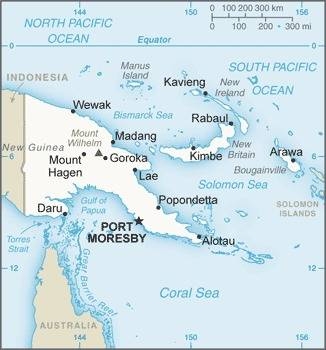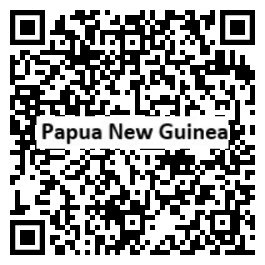Country Summary




Introduction
Background
The eastern half of the island of New Guinea was divided between Germany (north) and the UK (south) in 1885. The latter area was transferred to Australia in 1902, which occupied the northern portion during World War I and continued to administer the combined areas until independence in 1975. Since 2001, Bougainville has experienced autonomy. In a 2019 referendum, almost 98% of voters chose eventual independence.
Geography
Area
total: 462,840 sq km
land: 452,860 sq km
water: 9,980 sq km
Climate
tropical; northwest monsoon (December to March), southeast monsoon (May to October); slight seasonal temperature variation
Natural resources
gold, copper, silver, natural gas, timber, oil, fisheries
People and Society
Population
9,593,498 (2022 est.)
Ethnic groups
Melanesian, Papuan, Negrito, Micronesian, Polynesian
Languages
Tok Pisin (official), English (official), Hiri Motu (official), some 839 indigenous languages spoken (about 12% of the world's total); many languages have fewer than 1,000 speakers
Religions
Protestant 64.3% (Evangelical Lutheran 18.4%, Seventh Day Adventist 12.9%, Pentecostal 10.4%, United Church 10.3%, Evangelical Alliance 5.9%, Anglican 3.2%, Baptist 2.8%, Salvation Army 0.4%), Roman Catholic 26%, other Christian 5.3%, non-Christian 1.4%, unspecified 3.1% (2011 est.)
Population growth rate
2.35% (2022 est.)
Government
Government type
parliamentary democracy under a constitutional monarchy; a Commonwealth realm
Capital
name: Port Moresby
Executive branch
chief of state: King CHARLES III (since 8 September 2022); represented by Governor General Grand Chief Sir Bob DADAE (since 28 February 2017)
head of government: Prime Minister James MARAPE (since 30 May 2019); Deputy Prime Minister Sam BASIL (since 20 December 2020)
Legislative branch
description: unicameral National Parliament (111 seats; members directly elected in single-seat constituencies - 89 local, 20 provinicial, the autonomous province of Bouganville, and the National Capital District - by majority preferential vote; members serve 5-year terms); note - the constitution allows up to 126 seats
Economy
Economic overview
lower middle-income Pacific island economy; very diverse, primarily informal agricultural labor force; natural resource rich extraction account for export volume; growing youth population faces lack of formal employment; hit by COVID-19
Real GDP (purchasing power parity)
$36.69 billion (2020 est.)
Real GDP per capita
$4,100 (2020 est.)
Agricultural products
oil palm fruit, bananas, coconuts, fruit, sweet potatoes, game meat, yams, roots/tubers nes, vegetables, taro
Industries
copra crushing, palm oil processing, plywood production, wood chip production; mining (gold, silver, copper); crude oil and petroleum products; construction, tourism, livestock (pork, poultry, cattle), dairy products, spice products (turmeric, vanilla, ginger, cardamom, chili, pepper, citronella, and nutmeg), fisheries products
Exports
$10.6 billion (2018 est.)
Exports - partners
Australia 26%, China 26%, Japan 22%, Taiwan 7% (2019)
Exports - commodities
natural gas, gold, copper, lumber, crude petroleum, nickel, palm oil, fish, coffee (2019)
Imports
$4.84 billion (2018 est.)
Imports - partners
Australia 33%, China 19%, Singapore 14%, Malaysia 9% (2019)
Imports - commodities
refined petroleum, excavation machinery, crude petroleum, foodstuffs, delivery trucks (2019)
Exchange rates
kina (PGK) per US dollar -
Page last updated: Friday, December 16, 2022
